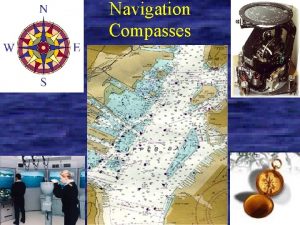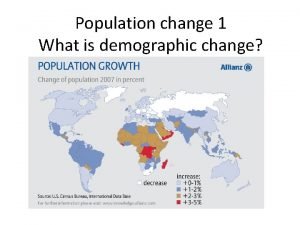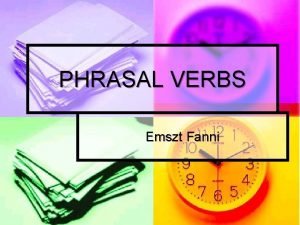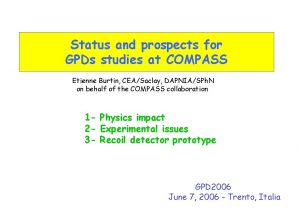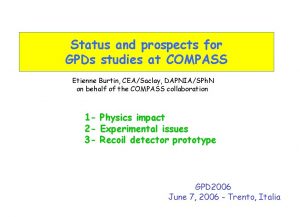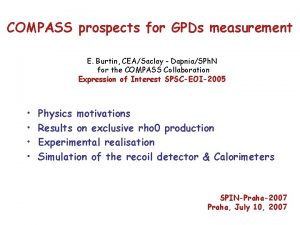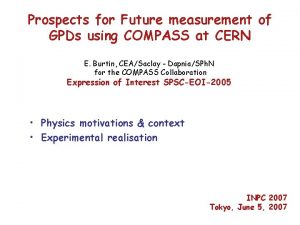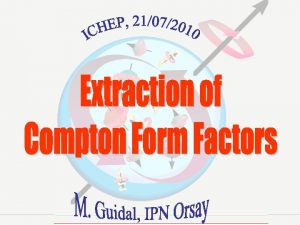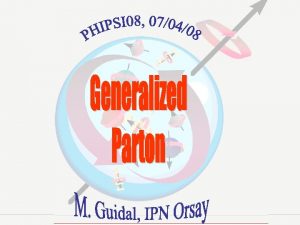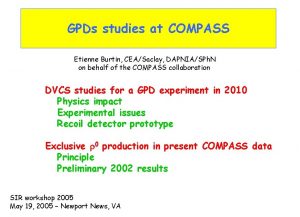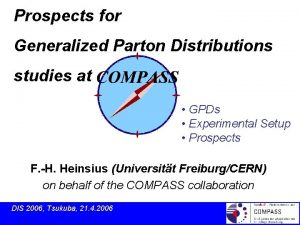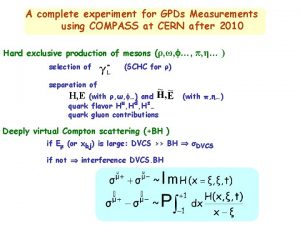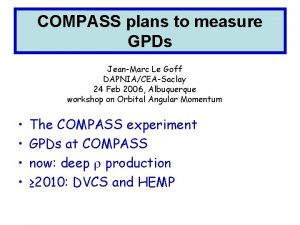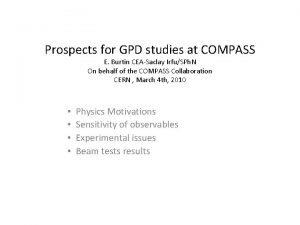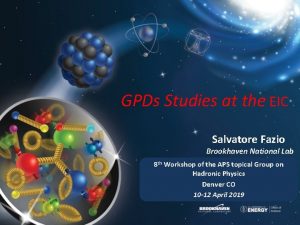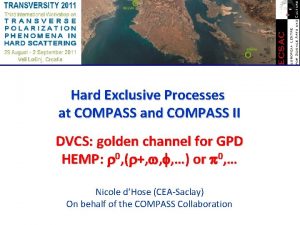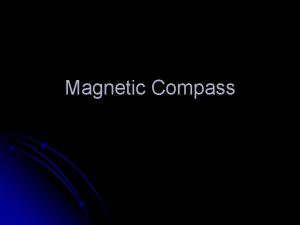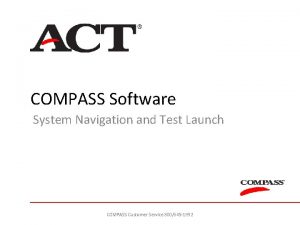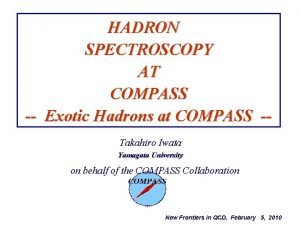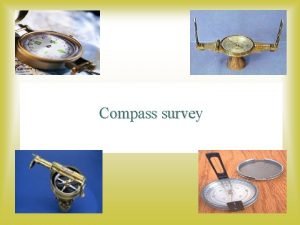Status and prospects for GPDs studies at COMPASS









































- Slides: 41

Status and prospects for GPDs studies at COMPASS Nicole d’Hose, CEA-Saclay On behalf of the COMPASS collaboration - Generalized Parton Distributions (GPDs) Sensitivity to COMPASS kinematics High luminosity and recoil Detection Meson production (present ρ studies) DVCS with polarized μ+ and μ- "Hadron Structure and Hadron Spectroscopy", Prague, August 1 st-3 rd, 2005

GPDs a 3 -dimensional picture of the partonic nucleon structure Deep Inelastic Scattering ep e. X γ* Hard Exclusive Scattering Deeply Virtual Compton Scattering ep ep Q²x. Bj x * p x+ z p x P x- GPDs t x P Parton Density q ( x ) Px z r x boost 0 1 p y x boost x Q² y Generalized Parton Distribution H( x, , t ) ( Px, ry, z ) Burkard, Belitsky, Müller, Ralston, Pire

Why GPDs are promising? Goal: correlation between the 2 pieces of information: -distribution of longitudinal momentum carried by the partons -distribution in the transverse plane Implication of orbital angular momentum to the total spin of a nucleon q q p t Nucleon spin: ½ = ½ ΔΣ + ΔG + < Lz > quark contribution EMC, SLAC, HERMES gluon contribution RHIC, HERMES, COMPASS p orbital angular momentum FUTURE

What do we learn from the 3 dimensional picture ( Px, ry, z ) ? 1. Lattice calculation: Negele et al. , NP Proc. Suppl. 128 (2004) fast parton close to the N center small valence quark core slow parton far from the N center widely sea q and gluons 2. Chiral Dynamics: Strikman et al. , PRD 69 (2004) at large distance, the gluon density is generated by the pion cloud significant increase of the N transverse size if x. Bj < mπ/mp=0. 14 COMPASS domain

GPDs and relations to the physical observables γ, π, ρ, ω… x-ξ x+ξ factorization t The observables are some integrals of GPDs over x Dynamics of partons Fit of Parameters to the data in the Nucleon Models: Parametrization Elastic Form Factors H, , E, (x, ξ, t) Ji’s sum rule “ordinary” parton density 2 Jq = x(Hq+Eq)(x, ξ, 0)dx x H(x, ξ, t)dx = F(t) x H(x, 0, 0) = q(x) (x, 0, 0) = Δq(x)

Parametrization of GPDs Model 1: H(x, ξ, t) ~ q(x) F(t) Model 2: is more realistic it considers that fast partons in the small valence core and slow partons at larger distance (wider meson cloud) it includes correlation between x and t <b 2 > = α’ln 1/x transverse extension of partons in hadronic collisions 2 H(x, 0, t) = q(x) e t <b > = q(x) / xα’t (α’slope of Regge traject. ) This ansatz reproduces the Chiral quark-soliton model: Goeke et al. , NP 47 (2001)

Necessity of factorization to access GPDs Collins et al. Deeply Virtual Compton Scattering (DVCS): γ* γ* Q 2 γ hard x+ξ Q 2 γ x+ξ x-ξ soft GPDs p t p p’ =Δ 2 t p’ =Δ 2 Q 2 large t << Q 2 Hard Exclusive Meson Production (HEMP): γ*L hard meson Q 2 x+ξ x-ξ γ*L Q 2 meson x-ξ x+ξ soft p GPDs t =Δ 2 p’ Quark contribution p GPDs t =Δ 2 p’ Gluon contribution + γ* L

E=190, 100 Ge. V Complementarity of the experiments in the world At fixed x. Bj, study in Q 2 0. 0001< x. Bj < 0. 01 Gluons H 1 and ZEUS PLB 517(2001) PLB 573(2003) Valence and sea quarks And Gluons Hermes PRL 87(2001) COMPASS plans Valence quarks JLab PRL 87(2001)

if Nμ 5 Q 2 < 17 Ge. V 2 Q 2 < 11 Ge. V 2 for DVCS Limitation by luminosity now Nμ= 2. 108μ per SPS spill for DVCS Q 2 < 7. 5 Ge. V 2 At fixed x. Bj, study in Q 2 E=190, 100 Ge. V if Nμ 2 Benefit of a higher muon intensity for GPDs study for DVCS

In 2010 ? sharing CNGS/FT operations new Linac 4 (high intensity H- source) as injector for the PSB + improvements on the muon line what could be the available proton/muon flux? COMPASS >>LINAC 4 From Lau Gatignon

Additional equipment to the COMPASS setup DVCS μp μ’p’ At these energies (for μ, μ’, and ) the missing mass technique is not adapted = (mp+mπ)2 -mp 2 = 0. 25 Ge. V 2 M 2 observed > 1 Ge. V 2 M 2 required μ’ ECal 1 or 2 12° + additional calorimeter at larger angle p’ μ Nμ=2. 108/SPS cycle (duration 5. 2 s, each 16. 8 s) 2. 5 m liquid H 2 target to be designed and built L = 1. 3 1032 cm-2 s-1 Recoil detector to insure exclusivity to be designed and built

Competing reactions to DVCS: μp HEπ°P: μp μpπ° Dissociation of the proton: μp μN*π° Nπ DIS: μp μp. X with 1 , 1π°, 2π°, η… Beam halo with hadronic contamination Beam pile-up Secondary interactions External Bremsstrahlung Selection DVCS/DIS with PYTHIA 6. 1 Tune parameters: -maximum angle for photon detection 30° -threshold for photon detection 50 Me. V -maximum angle for charged particle detection 30°

Key role of the Calorimetry ECAL 2 from 0. 4 to 2° mainly lead glass GAMS ECAL 1 from 2 to 12° good energy and position resolution for 2 photons separation in a high rate environment ECAL 0 from 12 to 30° to be designed for background rejection Careful study of photon and π0 production linked to the hadron program

possible solution to complete the COMPASS setup 30° ECAL 0 12° 4 m 2004 -2007: Received funding by EU FP 6 (Bonn-Mainz-Warsaw-Saclay) Goal: full test of feasibility of a 45° sector recoil detector - scintillating material studies (200 ps To. F Resolution over 4 m) - fast triggering and multi-hit ADC/TDC system

Before 2010, i. e. right now with the present COMPASS setup and the polarized 6 Li. D target Hard "exclusive" meson production studies

Hard exclusive meson production (ρ, ω, …, π, η… ) meson γ* L hard x + ξ Scaling predictions: x-ξ soft p GPDs t =Δ 2 p’ 1/Q 6 Collins et al. (PRD 56 1997): 1/Q 4 1. factorization applies only for γ* L vector mesons pseudo-scalar mesons 2. σT << σL ρ0 largest production ρ0 π+ π- present study with COMPASS

Description of the diffractive ρ° production μN μ’N’ρ + π π * Q 2 W N’ N t COMPASS 2002: 10 -2<Q 2<10 Ge. V 2, <W>=10 Ge. V, t small At Q 2 > 1 Ge. V 2 QCD calculations (for σL) with GPDs and with exchange of 2 quarks or 2 gluons Regge theory: at low energy W < 5 Ge. V: exchange of Reggeon ρ, ω (JP=1 -), a 2, f 2 (JP=2+), a 3, f 3 (JP=3 -), … at higher energy : exchange of Pomeron Experimental observations (NMC, E 665, ZEUS, H 1, HERMES): the helicity of γ* is approximatively retained by the ρ° meson SCHC the exchange object has natural parity P=(-1)J NPE

Spin properties of the production amplitudes Angular Distribution of the production and decay of ρ π +π - Spin density matrix elements bilinear combinations of the helicity amplitudes A( γ*(λγ ) ρ(λρ ) ) λγ= 1, 0 if NPE Tλρ λγ λρ= 1, 0 T- λ ρ -λγ = (-1) λρ-λγ Tλρ λγ 9 helicity amplitudes reduce to five 5 independent amplitudes : A(L L), A(T T) i. e. T 00 , T 11 SCHC >> >> >> A(T L) T 01 > A(L T) > A(T -T) > T 10 > T-11 single helicity flip > double helicity flip SCHNC

Incoherent exclusive ρ0 production Q * 2 Mpp Assuming both hadrons are p 0. 5 < Mpp< 1 Ge. V Emiss Exclusivity of the reaction Emiss=(M²X-M²N) /2 MN -2. 5 < Emiss < 2. 5 Ge. V p t² Incoherent production 0. 15 < pt²< 0. 5 Ge. V² scattering off a quasi-free nucleon W N 6 Li. D N’ t polarized target Kinematics: ν > 30 Ge. V Eμ’ > 20 Ge. V Q² > 0. 01 Ge. V² Background ~12%

ρ° angular distributions W(cosθ, φ, Φ) depends on the Spin density matrix elements 23 (15) observables with polarized (unpolarized) beam φ This analysis: only one-dimensional angular distribution We will use also: ψ= φ - Φ

Angular distributions 0. 01 < Q² < 0. 05 < <Q² Q² < < 2. 0 < < Q² Q² < 10 Ge. V 2 0. 01 < Q² < 0. 05 Q²< <0. 3< < Q² Q² << 0. 6 << Q² φ Preliminary : - Corrected for Acceptance, smearing and efficiency (MC: DIPSI gen) Statistical error only, limited by MC - Background not subtracted

Measurement of r 04 00 0. 01 < Q² < 0. 05 < Q² < 0. 3 < Q² < 0. 6 < Q² < 2. 0 < Q² < 10 Ge. V 2 Distribution : Spin density matrix elements: Tλρ λγ are helicity amplitudes meson photon

Determination of Rρ° =s. L/s. T If SCHC holds : only T 00≠ 0 T 11≠ 0 Then : Impact on GPD study: easy determination of s. L factorisation only valid for s. L is dominant at Q 2>2 Ge. V 2 2003 + 2004 - High statitics from γ-production to hard regime - Better coverage at high Q 2 with 2003 and 2004 data

04 and Im r 3 Measurement of r 1 -1 φ Distribution : beam polarisation Spin density matrices: la k a we o vi If SCHC holds n tio

‘’ Longitudinal ’’ Meson production : filter of GPDs Cross section: Vector meson production (ρ, ω, …) Pseudo-scalar production (π, η… ) H ~ H & & E ~ E Hρ0 = 1/ 2 (2/3 Hu + 1/3 Hd + 3/8 Hg) Hω = 1/ 2 (2/3 Hu – 1/3 Hd + 1/8 Hg) H = Single spin asymmetry -1/3 Hs - 1/8 Hg ~ E/H for a transverse polarized target ed ASS t ga MP i t es CO v in nt e e b s e n r ca h p wit a t da

Meson Production in 2010 With a liquid Hydrogen target and the same muon flux than now Measurement of hard exclusive meson production comfortable statistics until Q 2= 20 Ge. V 2 Q 2= 7 Ge. V 2 Benefit of an increase in intensity for an extension of the range in Q 2 NB: for results from JLab the SCHC was not observed at Q 2 < 4 Ge. V 2 and large x. Bj~ 0. 4

towards a complete experimental program with a liquid H 2 target, a recoil detector, an extended calorimetry for both HEMP and DVCS in 2010

Polarized μ+ and μ- beams 1. to maximise the muon flux (Lau Gatignon) 2. Pπ=110 Ge. V and Pμ=100 Ge. V Pol(μ+) = -0. 8 and Pol(μ-) = +0. 8 Nμ+ ~ 2. Nμ- T 6 primary Be target Collimators 1 2 3 4 H V scrapers Compass target Be absorbers Protons 400 Ge. V Hadron decay section 600 m 1. 3 1013 protons/spill Muon section 400 m 2. 108 muons/spill

μ DVCS+ Bethe Heitler p The high energy muon beam at COMPASS allows to play with the relative contributions DVCS-BH which depend on 1/y = 2 mp Eℓ x. Bj /Q 2 Higher energy: DVCS>>BH DVCS Cross section Smaller energy: DVCS~BH ÞInterference term will provide the DVCS amplitude μ μ’ * φ p θ μ p BH calculable

Advantage of and for Deeply virtual Compton scattering (+Bethe-Heitler ) t, ξ~x. Bj/2 fixed dσ(μp μp ) = dσBH + dσDVCSunpol + Pμ dσDVCSpol + eμ a. BH Re ADVCS cos nφ μ μ’ * φ + eμ Pμ a. BH Im ADVCS sin nφ θ p Pμ+=-0. 8 Pμ-=+0. 8 Diehl

DVCS Beam Charge Asymmetry (BCA) measured with the 100 Ge. V muon beam at COMPASS BCA Q 2=4 0. 5 Ge. V 2 x = 0. 05 ± 0. 02 Model 1: H(x, ξ, t) ~ q(x) F(t) 2 Model 2: H(x, 0, t) = q(x) e t <b > = q(x) / xα’t In 2010 L = 1. 3 1032 cm-2 s-1 efficiency=25% 150 days data taking In total φ BCA x = 0. 10 ± 0. 03 Only 2/18 data sets 3 bins in x. Bj= 0. 05, 0. 1, 0. 2 6 bins in Q 2 from 2 to 7 Ge. V 2 φ

Advantage of the kinematical domain of COMPASS Model 1: H(x, ξ, t) ~ q(x) F(t) BCA 2 Model 2: H(x, 0, t) = q(x) e t <b > model 1 = q(x) / xα’ t model 2 COMPASS sensitivity to the different spatial distribution of partons when x. Bj range of COMPASS

Competition to COMPASS measurements at COMPASS in 2010 compared to: HERMES in the same x. Bj intermediate range but reduced kinematical domain in Q 2 H 1, ZEUS (x. Bj<10 -2) about 2 data years until 2007 equivalent integrated luminosity/year with new recoil detection JLab 6 Ge. V (large x. Bj) 11 Ge. V in 2011? very high luminosity e-RHIC in the far future around 2015? high energy in the collider mode high luminosity

COMPASS 6 angular distributions among 18: 3 bins in x. Bj=0. 05, 0. 1, 0. 2 6 bins in Q 2 from 2 to 7 Ge. V 2 BCA in DVCS projections for 1 year HERMES one single bin <x>=0. 11 <Q 2>=2. 6

Roadmap for GPDs at COMPASS This initiative is now an "Expression of Interest": SPSC-E 0 I-005 2004 -2009: Present COMPASS studies with the polarized target Complete analysis of ρ production SCHC study in a large range in Q 2 0. 02 -20 Ge. V 2 NPE study with longitudinal double spin asymmetry E/H investigation with the transverse polarized target Other channels: , 2π … 2004 -2007: Realization of the recoil detector prototype within the EU FP 6 2007 -2009: construction of the recoil detector cryogenic target, ECal 0 ³ 2010: complete experiment for GPDs study at COMPASS benefit directly of every improvement of the muon flux and of the intensity upgrade of the SPS

Not presented… Other measurements with the high intensity and the unpolarised target

Kinematical domains for colliders and fixed target experiments until Q 2 = 10 -3 COMPASS x = 3. 10 -5

Success of QCD The NLO DGLAP equations describe the Q 2 evolution of F 2 Possible New Accurate Measurement At COMPASS proton

Understanding of low x physics ZEUS H 1 New phenomena Coherent interaction of partons Log 1/x in the QCD evolution y=Q 2/xs Transition from high to low Q 2 to understand confinement Saturation model New data at low x low Q 2 with COMPASS Saturation model Bartels, Golec-Biernat, Kowalski PRD 66 (2002)

Quark and gluon contributions NMC 94 E 665 97 ZEUS 93+95 Preliminary errors for COMPASS 2003 (6 Li. D) Gluon GPD calculations: Frankfurt et al. PRD 54 (1996) Quark GPD calculations: Vanderhaeghen et al. PRD 60 (1999) Gluon contribution Quark contribution

 Gpds eduscol
Gpds eduscol Whole circle bearing and quadrantal bearing
Whole circle bearing and quadrantal bearing True bearing vs relative bearing
True bearing vs relative bearing Quantum computing progress and prospects
Quantum computing progress and prospects The phrase elysian prospects suggests the
The phrase elysian prospects suggests the Prospects of agriculture in bangladesh
Prospects of agriculture in bangladesh World population prospects
World population prospects Prospects preposition
Prospects preposition Paradigm shift from women studies to gender studies
Paradigm shift from women studies to gender studies Fspos
Fspos Novell typiska drag
Novell typiska drag Tack för att ni lyssnade bild
Tack för att ni lyssnade bild Ekologiskt fotavtryck
Ekologiskt fotavtryck Varför kallas perioden 1918-1939 för mellankrigstiden?
Varför kallas perioden 1918-1939 för mellankrigstiden? En lathund för arbete med kontinuitetshantering
En lathund för arbete med kontinuitetshantering Personalliggare bygg undantag
Personalliggare bygg undantag Personlig tidbok fylla i
Personlig tidbok fylla i A gastrica
A gastrica Densitet vatten
Densitet vatten Datorkunskap för nybörjare
Datorkunskap för nybörjare Tack för att ni lyssnade bild
Tack för att ni lyssnade bild Debatt mall
Debatt mall Delegerande ledarskap
Delegerande ledarskap Nyckelkompetenser för livslångt lärande
Nyckelkompetenser för livslångt lärande Påbyggnader för flakfordon
Påbyggnader för flakfordon Formel för lufttryck
Formel för lufttryck Svenskt ramverk för digital samverkan
Svenskt ramverk för digital samverkan Jag har nigit för nymånens skära
Jag har nigit för nymånens skära Presentera för publik crossboss
Presentera för publik crossboss Teckenspråk minoritetsspråk argument
Teckenspråk minoritetsspråk argument Kanaans land
Kanaans land Klassificeringsstruktur för kommunala verksamheter
Klassificeringsstruktur för kommunala verksamheter Mjälthilus
Mjälthilus Claes martinsson
Claes martinsson Centrum för kunskap och säkerhet
Centrum för kunskap och säkerhet Programskede byggprocessen
Programskede byggprocessen Mat för idrottare
Mat för idrottare Verktyg för automatisering av utbetalningar
Verktyg för automatisering av utbetalningar Rutin för avvikelsehantering
Rutin för avvikelsehantering Smärtskolan kunskap för livet
Smärtskolan kunskap för livet Ministerstyre för och nackdelar
Ministerstyre för och nackdelar Tack för att ni har lyssnat
Tack för att ni har lyssnat


